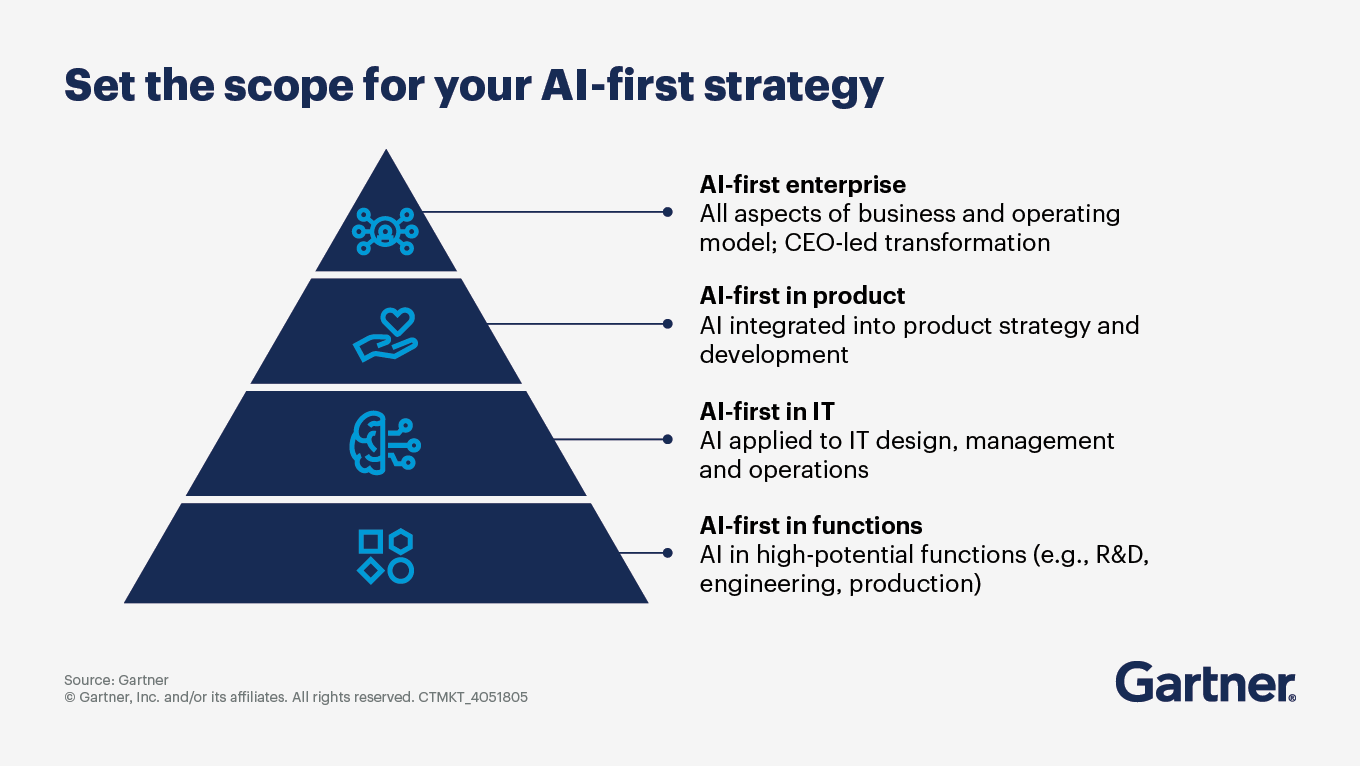It’s not about using AI everywhere — it’s about always exploring its potential.
- Gartner client? Log in for personalized search results.
AI-First Strategy: How to Outperform Your Competition by 2028
By Rajesh Kandaswamy | November 5, 2025
AI-first strategy delivers sustained business performance
Gartner predicts that by 2028, organizations that adopt and sustain an AI-first strategy will achieve 25% better business outcomes than competitors. But what does an AI-first strategy actually entail? It requires considering AI as a primary option for every decision and investment — and choosing to use the technology where it delivers the greatest value.
The shift to AI-first accelerates AI adoption, improves AI literacy and fosters continuous learning, so organizations can uncover new sources of value and resilience. AI-first demands new ways to measure success, tracking shifts in behaviors, mindsets and the effectiveness of learning and feedback.
Want deeper insights on being an AI-first organization? AskGartner gives clients immediate answers backed by Gartner expert insights.
AI-first is not “AI-always”
Forced adoption of AI isn’t the answer. Define “AI-first” for your organization, set a clear governance framework and communicate plans to keep teams aligned.
When to adopt an AI-first approach for maximum value
Organizations that invest in AI yet struggle to maximize value from their investments should consider the AI-first approach. It is particularly critical in organizations that see:
A widening gap between AI’s perceived potential and the value realized from existing use cases
Systems, processes and mindsets preventing large step-changes
High potential for large-scale disruption or transformation fueled by AI
A disconnect between leadership that is ready to enable transformational change and an organization that is unable or unwilling
That significant investment and learning curves may be necessary before the organization sees real adoption of AI
Set the scope for your AI-first strategy
Organizations can apply an AI-first approach at any level. Where you start depends on which areas show the greatest potential for achieving transformational benefits from AI. Representative approaches include:
AI-first enterprise: This scope applies to all aspects of the business and operating model and aims to achieve broad transformation or uncover new sources of competitive advantage. The CEO champions an enterprise-level approach with commitment across the organization.
AI-first in product: At this level, AI is integral to product strategy and development. Medium to large tech companies and digital pure-plays often embrace AI-first in this way.
AI-first in IT: This scope is suitable for organizations that rely on IT for all aspects of their business. It applies to IT design, development, integration, management and operations, as well as to all platforms, applications, data and infrastructure, whether built internally or sourced from vendors.
AI-first in other functions: This approach is relevant for enterprises with functional areas (e.g., R&D, engineering, production) that have high potential to derive AI impact and are more ready to embrace AI than the organization as a whole.
The AI-first enterprise approach offers the most benefits — but it also comes with the most risk. That’s why many enterprises start by applying AI-first in specific areas and evolve from there.
Expect short-term disruption in service of long-term impact
Upon adopting an AI-first approach, organizations may underperform thanks to existing gaps in knowledge, technology maturity or overall AI readiness. Recognize the possibility of temporary performance reduction, communicate with teams and provide adequate support when setbacks occur.
Effective change management is also critical for success. Address employee concerns and resistance by engaging the workforce in your AI-first efforts, providing targeted retraining, and communicating the benefits and safeguards to prevent harm from AI.
AI-first FAQs
What is an AI-first strategy?
An AI-first strategy makes artificial intelligence a default consideration when addressing business challenges. It ensures organizations prioritize AI-driven solutions wherever these solutions can deliver superior outcomes.
How does an AI-first strategy improve business outcomes?
Gartner insights show that enterprises that adopt an AI-first strategy can achieve up to 25% better results than competitors by accelerating innovation, improving efficiency and uncovering new opportunities.
What are common barriers to implementing an AI-first strategy?
Barriers to implementing an AI-first strategy include legacy systems, cultural resistance, lack of skills or knowledge about AI technologies, and insufficient leadership commitment to widespread change.
Attend a Conference
Accelerate growth with Gartner conferences
Gain exclusive insight on the latest trends, receive one-on-one guidance from a Gartner expert, network with a community of your peers and leave ready to tackle your mission-critical priorities.

Drive stronger performance on your mission-critical priorities.
